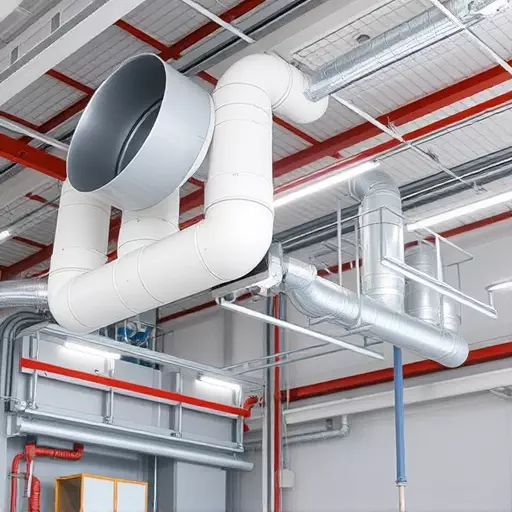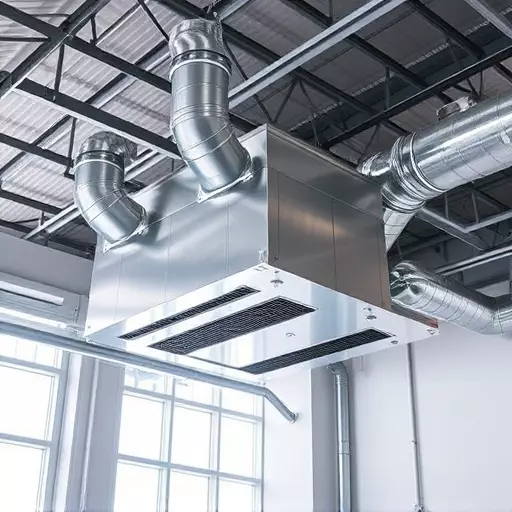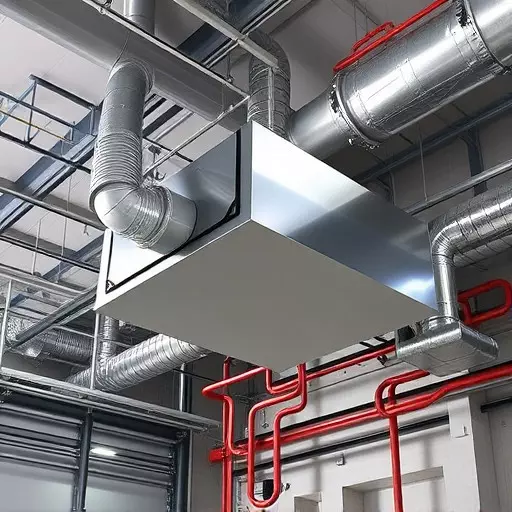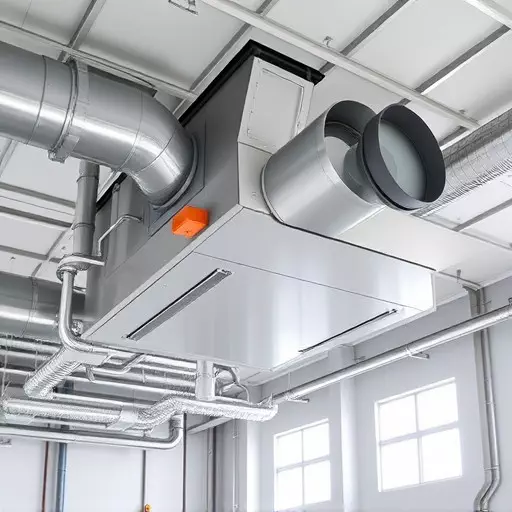Industrial settings require specialized ventilation strategies, focusing on exhaust and supply systems, to ensure worker safety and environmental control. Effective solutions involve strategic vent placement, ductwork design, and fan usage to minimize stagnant areas and hot spots. By combining local exhaust ventilation near hazards with general supply ventilation, facilities can remove toxic fumes, dust, and contaminants, providing clean, breathable air. Regular maintenance and adherence to industry standards solidify safety protocols, enhancing worker safety and productivity in sectors like manufacturing and construction.
In industrial settings, proper ventilation is more than just a comfort; it’s a critical safety protocol. This article delves into comprehensive industrial ventilation solutions, focusing on exhaust and supply ventilation systems. We explore how these systems play a pivotal role in safeguarding workers from hazardous fumes and dust. From understanding intricate ventilation mechanisms to implementing best practices and learning from successful case studies, this guide equips professionals with essential knowledge for maintaining optimal ventilation safety protocols.
- Understanding Ventilation Systems in Industrial Settings
- The Role of Exhaust Ventilation in Worker Safety
- Implementing Effective Supply Ventilation Systems
- Common Safety Hazards and How to Mitigate Them
- Best Practices for Maintaining Ventilation Safety Protocols
- Case Studies: Successful Industrial Ventilation Solutions
Understanding Ventilation Systems in Industrial Settings

Industrial settings require robust and tailored ventilation solutions to ensure worker safety and environmental control. Understanding the intricacies of industrial ventilation systems is paramount for managing air quality, preventing health hazards, and enhancing overall workplace well-being. These systems are designed to manage both exhaust ventilation solutions, removing potentially harmful pollutants and gases, and supply ventilation systems, providing fresh air to maintain optimal oxygen levels.
Effective industrial ventilation involves strategic placement of vents, ductwork, and fans to create a flow that minimizes stagnant areas and hot spots. By leveraging the right combination of extraction and introduction of air, these systems can mitigate risks associated with toxic fumes, dust, and other airborne contaminants. This knowledge enables facilities to implement appropriate measures, such as local exhaust ventilation near specific hazards or general supply ventilation to maintain clean, breathable air throughout the workspace.
The Role of Exhaust Ventilation in Worker Safety

In industrial settings, worker safety is paramount, and proper ventilation plays a crucial role in mitigating health risks. Exhaust ventilation solutions are designed to remove hazardous pollutants, fumes, and gases from the workspace, ensuring a safer and healthier environment for employees. By facilitating the extraction of harmful substances, these systems prevent their accumulation, which can lead to respiratory issues, chemical burns, or even fatal accidents.
Industrial ventilation solutions, including exhaust ventilation and supply ventilation systems, are essential components of any comprehensive workplace safety program. Exhaust systems specifically target the removal of pollutants at their source, while supply systems provide clean air to workers. The integration of these industrial ventilation solutions not only enhances air quality but also reduces noise levels, improves visibility, and maintains a comfortable temperature, fostering a productive and safe work environment.
Implementing Effective Supply Ventilation Systems

Implementing effective supply ventilation systems is paramount in ensuring optimal air quality and worker safety within industrial environments. These systems play a pivotal role in controlling airborne contaminants, temperature regulation, and overall health hazards. By strategically placing supply vents, businesses can introduce clean, fresh air into work areas, thereby diluting and dispersing potentially hazardous substances. This is particularly crucial for industries involving chemical processing, metalworking, or any other operations that generate harmful fumes or particulate matter.
Industrial ventilation solutions, including exhaust ventilation systems, work in harmony with supply vents to create a balanced airflow pattern. The primary objective is to maintain a safe and healthy atmosphere by preventing the accumulation of noxious gases and dust particles. For instance, in manufacturing plants, well-designed supply ventilation systems can capture and contain emissions at their source, preventing them from spreading throughout the facility. This proactive approach not only enhances air quality but also reduces the risk of respiratory issues for employees and minimizes potential environmental impact.
Common Safety Hazards and How to Mitigate Them

In any industrial setting, ensuring proper ventilation safety is paramount to protect workers from a multitude of hazards. Common dangers include airborne contaminants, toxic gases, and inadequate oxygen levels. To mitigate these risks, implementing robust industrial ventilation solutions is key. This involves designing efficient exhaust ventilation solutions to remove harmful substances and dangerous levels of carbon monoxide or volatile organic compounds (VOCs).
Effective supply ventilation systems should be integrated into the workspace to introduce clean air, ensuring a safe and healthy atmosphere for employees. Regular maintenance and monitoring are crucial to identify and rectify any issues promptly. By adopting these strategies, businesses can significantly reduce accidents and promote a safer working environment, aligning with best practices in industrial health and safety.
Best Practices for Maintaining Ventilation Safety Protocols

Maintaining safe and efficient ventilation is paramount in any industrial setting. To ensure optimal safety protocols, regular system checks and maintenance are crucial. This includes inspecting ductwork for leaks or blockages, testing exhaust ventilation solutions to guarantee adequate air flow, and verifying the functionality of supply ventilation systems. Implementing these best practices not only enhances worker safety by preventing hazardous buildup of fumes or dust but also ensures the longevity of your industrial ventilation solutions.
Additionally, staying up-to-date with industry standards and regulations is essential. This involves incorporating advanced technologies that offer more precise control over air quality and circulation. Regular training for employees on proper usage and maintenance procedures further solidifies a culture of safety. By adhering to these practices, businesses can create a healthier, safer environment while maximizing the efficiency of their exhaust ventilation solutions and supply ventilation systems.
Case Studies: Successful Industrial Ventilation Solutions

In the realm of industrial safety, proper ventilation is a game-changer. Case studies from various sectors highlight successful implementations of industrial ventilation solutions. For instance, in manufacturing plants, efficient exhaust ventilation systems have significantly reduced worker exposure to hazardous fumes and improved overall air quality. These systems are designed to swiftly remove contaminated air, replacing it with fresh supplies, thereby fostering a safer and healthier work environment.
Similarly, construction sites benefit from tailored supply ventilation systems that provide clean, breathable air to workers. By strategically placing vents and using advanced fans, these systems mitigate the risk of respiratory issues associated with dust and other airborne contaminants. Such solutions not only enhance worker safety but also increase productivity by ensuring employees can perform their tasks without concern for inadequate ventilation.


